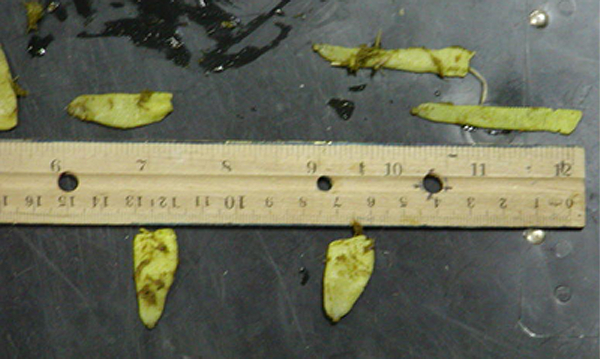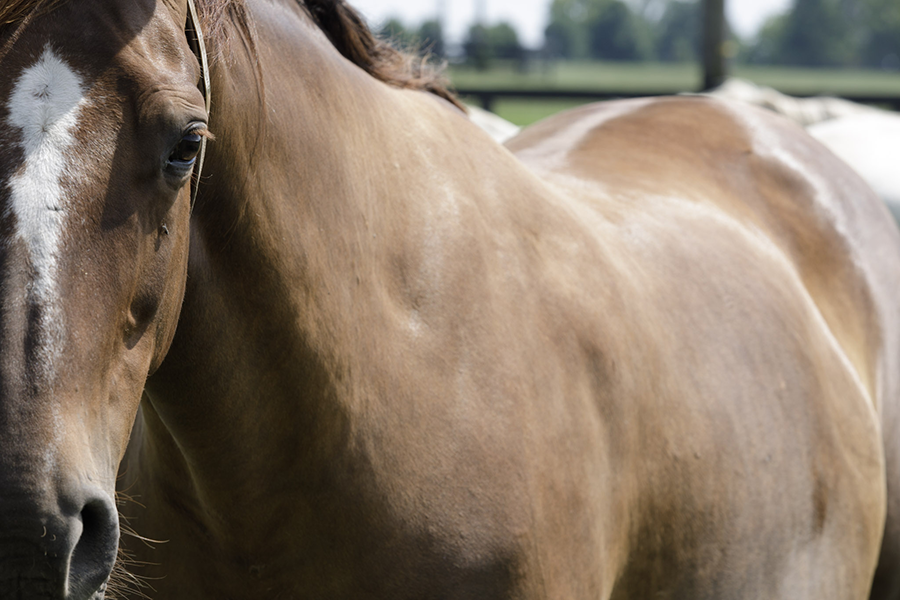
Equine Health Library
Pleasure Horse
Wellness & Prevention
Immunology | Parasitology | Nutrition | Dental Care | Hoof Care
Immunology
Immunology
If your horse is kept at a boarding barn with multiple owners, veterinarians and vaccination protocols, herd-wide disease prevention is even more challenging. Most infectious equine diseases are far easier and less expensive to vaccinate against than to treat.
Preventing Disease
That’s why veterinarians recommend that all horses receive some combination of vaccines every year based on risk. The American Association of Equine Practitioners (AAEP) provide guidelines for horses based on age and risk of disease. Those guidelines can be found here: AAEP’s guide to vaccination. To learn which vaccines your pleasure horse may need, talk to your veterinarian.
Pleasure horses may also be exposed to some diseases that cannot be prevented by vaccination. Talk with your veterinarian about your horse’s risk for diseases such as pigeon fever, Lyme disease and equine protozoal myeloencephalitis (EPM).
Action Item
- Vaccinate pleasure horses once or twice per year depending upon disease risk.
- Download the Equine Health Library Pleasure Horse Vaccination Guide
Parasitology
Deworming the Pleasure Horse
Talk to your veterinarian about a strategic deworming program for your pleasure horse. A strategic deworming program is a plan that controls parasites based on your horse’s needs rather than an arbitrary schedule. Strategic deworming is our strongest tool to slow the progression of parasite resistance to our deworming medications.
Deworming tips
- Consult with your veterinarian to determine the needs of your horse through fecal egg count examinations and specifics for your local geographic area.
- Deworm strategically – this means only deworm the horses that need to be dewormed and at the most effective time for your climate.
- Use a weight tape (or scale) to avoid under-dosing. Horses are generally heavier than you think. If you don’t have a weight tape, you can also use this equation to estimate your horse’s body weight: Body weight (lbs.) = Heartgirth (in.) x Heartgirth (in.) x Body length (in.) divided by 330. (The heartgirth is measured as the circumference over the withers and around the barrel; the body length is measured from the point of the shoulder to the point of the buttocks)
- During hot, dry summers (greater than 85 degrees Fahrenheit) and cold, freezing winters, you can decrease the frequency of deworming as any parasite eggs shed onto pastures during these conditions will not survive long.
- Larvicidal dewormers (e.g., PANACUR® (fenbendazole) POWERPAC®) are most effective if given at the end of grazing season in your region (e.g., prior to hot, dry summers and/or cold, freezing winters).
- If tapeworms are a problem in your area, use a double dose of pyrantel or a dewormer that contains praziquantel at least once a year.
- Quarantine new arrivals and check fecal egg counts. Use a larvicidal treatment, such as the larvicidal dose of fenbendazole (PANACUR® POWERPAC®) or moxidectin, before turning new arrivals out on pastures. Hold new arrivals in their stall for at least 72 hours after deworming before turning out on community pastures.
Important Safety Information
PANACUR: NOT FOR USE IN HUMANS. KEEP OUT OF REACH OF CHILDREN. Do not use in horses intended for human consumption.

These tapeworm segments can cause intestinal disease in grazing horses. Spasmodic colic and ileo-cecal intussusception are two forms of colic associated with tapeworm infection.
Top 10 non-chemical parasite control tips
- Don’t overstock pastures or allow pastures to become overgrazed
- Remove manure from stalls daily and from paddocks and pastures twice weekly before strongyle eggs have a chance to hatch and develop into infective larvae (about five to seven days during optimal conditions)
- Keep pasture roughs (areas where horses defecate and do not graze) mowed to a height less than or equal to 3-8 inches
- During hot, dry weather, harrow or rake pastures to disperse manure piles and expose larvae to sun. Rest the pasture at least four weeks after harrowing.
- Cross-graze pastures with other species. Cattle and sheep serve as biological vacuums for equine parasites.
- Make at least one cutting of hay off some pastures to help reduce the parasite burden
- Plant an annual crop such as winter wheat
- Feed hay and grain in raised containers and not directly on the ground
- Clean water sources regularly to prevent fecal contamination
- Compost manure. Properly composted manure will kill strongyle larvae and many ascarid eggs

Damage done to the lining of the mesenteric artery by migrating large strongyle larvae.
Click the link to download the Equine Health Library Pleasure Horse Deworming Record.
Nutrition
Body Condition Scoring
Monitoring your horse’s weight is an important way to keep track of his overall health. The best way to measure and monitor your horse’s body fat is through Body Condition Scoring. The target for most horses is to be a body condition score of 5, where ribs aren’t visible but are easy to feel. Being underweight or overweight affects your horse’s health and wellbeing. Of particular concern in the obese horse population is the high risk for insulin resistance. Obesity and insulin resistance are risk factors for laminitis, which is a painful condition that affects a horse’s welfare and athletic ability.

Image of a healthy horse’s body fat on body condition scoring.
Research reveals that body fat is a very metabolically active tissue. Fat cells produce hormones that regulate energy intake and expenditure. Excess fat results in higher production of the stress hormone, cortisol, and lower levels of growth hormone as well as reduces tissue sensitivity to the action of insulin. All of this may contribute to oxidative and inflammatory stresses on the body.
Ways to safely reduce weight
It’s simple calorie economics: If you want your horse to lose weight, he needs to expend more calories than he consumes. The hard part is when you have a calorie-efficient horse that seems to gain weight on air. Your easy keeper may not even be eating grain. So how do you reduce calories when there’s no food to cut?
Tips to Reduce Weight
- Limit turnout time on pasture because lush pasture can be high in calories
- Utilize a grazing muzzle to slow down pasture intake
- Maintain the horse in a dry lot with measured hay intake
- Supplement hay or pasture with a ration balancer, which is designed to be fed at one to two pounds per day. A ration balancer allows us to decrease excess calories while still meeting protein, vitamin and mineral requirements.
As always, if your horse gains or loses weight too quickly or unexpectedly, call your veterinarian. It could be a sign of an underlying health issue.
Feeding a Hard Keeper
If your pleasure horse is a chronically hard keeper, first check with your veterinarian to rule out a medical reason for low body weight and condition. Chronic pain, respiratory, gastrointestinal or kidney disease, parasite infestation, dental abnormalities, and many other medical conditions can all affect a horse’s feed intake and utilization.
If there are no medical conditions to be resolved, then evaluate the forage portion of the diet. If your pasture/hay is of poor quality or an inadequate amount (minimum of 2% of bodyweight per day unless actively trying to decrease your horse’s weight), you may need to find another source of forage or consider utilizing a complete feed with forage included.
If the forage quality and amount is adequate, you may need to provide additional calories in the form of a concentrate. All diet changes must be made slowly to avoid GI upset. Slowly increase the amount fed per day until you reach the desired amount – no more than one pound/day of feed increase. Another option is to use a fat supplement to provide very concentrated, efficient calories to help support the desired increase in body condition. If your horse does not gain weight with appropriate diet modifications, seek guidance from your veterinarian.
Weight gain and bloom are achieved not only through calories, but also from providing a diet complete with essential amino acids, fatty acids, vitamins, and minerals. All these nutrients play a role in hair coat quality, muscle tone, hoof quality, and overall appearance and health.
Dental Care
Dental Care Every Horse Needs
Proper dental care is essential to your horse’s health. As your horse ages, his incisors, premolars, and molars continue to erupt (grow out) from the jaw, gradually being worn down by grazing and chewing.
Dental problems
A horse’s upper jaw is wider than the lower jaw, resulting in a normal malocclusion that causes sharp enamel points to develop along the outer edge of the upper cheek teeth and inner edge of the lower cheek teeth.
These sharp points can cause pain and discomfort, lacerations of the cheek and tongue, spillage of grain, and poor utilization of feed. Routine floating (filing) of these sharp enamel points helps maintain a normal, healthy oral cavity and teeth.
Other common dental abnormalities include retained caps (deciduous/baby teeth that are not shed), discomfort due to presence of wolf teeth, hooks forming on upper or lower cheek teeth, missing or broken teeth, abnormal or uneven bite planes (wave mouth or step mouth), excessively worn teeth, abnormally long teeth, infected teeth and/or gums, and periodontal (gum) disease.
The best course of action is prevention and attending to your horse’s teeth before problems happen. Every horse should have a thorough oral examination at least once a year. Don’t wait until your horse is showing signs of a potential problem as horses are experts at hiding pain. They will continue to eat through sometimes severe abnormalities.
Signs Your Horse Needs an Oral Examination
- Loss of feed from the mouth while eating
- Excessive salivation
- Difficulty chewing
- Loss of body condition
- Accumulation of wads of feed between the cheek and cheek teeth
- Foul odor from the mouth or nostril
- Swelling of the face
- Undigested feed in the manure
- Tilting or tossing of the head while eating or when bridled
- Tongue lolling, bit chewing, and/or fighting the bit
- Poor performance
Click the link to download the Equine Health Library Pleasure Horse Dental Record.
Hoof Care
Farrier Care for the Pleasure Horse
Taking care of your horse’s hooves is one of the most important things you can do to keep your pleasure horse sound and healthy.
Most horses benefit from trimming and/or shoeing every six to 10 weeks depending on the individual horse and specific hoof care needs such as corrective shoeing, hoof growth, and hoof condition. If your horse has trouble holding shoes or has hooves that crack and chip easily, look to nutrition first. Your horse may not be getting all of the nutrients he needs to grow a strong foot.
If your horse starts having problems such as sole abscesses, laminitis, or heel pain, in can be helpful to coordinate treatment with both your veterinarian and farrier for the best results.
Thrush
Thrush is a bacterial infection of the frog caused by gram-negative, anaerobic (requiring an environment with no oxygen in order to survive) bacteria. Wet, moist conditions favor development of thrush.
Signs of thrush include black, foul-smelling, greasy discharge around the frog and adjacent tissues. Severe cases can even cause lameness if the infection invades deeper tissues of the sole and frog. Call your veterinarian if you think thrush has progressed to this state. The goal with treatment is to keep the affected area clean and dry and provide more air to the site of infection.
Treatment Tips
- Clean dirt and mud away from the frog daily
- Treat topically with a povidine–iodine solution or other over-the-counter thrush medications
- Keep the feet dry and clean to reduce the risk of thrush
Don’t know a good farrier? Let us help. Find a Farrier
